
 Somewhat Recommended ** “ 70 Scenes of Halloween” is about two broken people who lose sight of their souls. Once they give up on love, they give up on life and stray into darkness. It is also a larger story about the unknown: the influence of the subconscious on our actions.
Somewhat Recommended ** “ 70 Scenes of Halloween” is about two broken people who lose sight of their souls. Once they give up on love, they give up on life and stray into darkness. It is also a larger story about the unknown: the influence of the subconscious on our actions.
But the play only superficially has to do with Halloween. In the opening scenes, the doorbell is constantly ringing as kids demand candy. There are ghosts, goblins, beasts, devils, and witches throughout the performance plus the requisite horror that people associate with the eerieness of the holiday.
The story is actually about a bad marriage and the repercussions of an adulterous affair. As Jess (Brandi Champagne) and her partner Joan (Kaitlin Eve Romero) grow more disenchanted with each other, Jess cheats on Joan with another woman. Jess is sorry for what she has done and is sincerely apologetic. However, as time wears on, Joan sees herself and Jess as being mortally wounded as a couple. The more Joan rejects Jess’s endless professions of love, the more Jess sees demons in the figures of the beast (Jo Hoch) and the witch (a truly remarkable performance by Kevin Blair). Hoch and Blair also double as a she-devil and her bird-like familiar.
Once the faithlessness is out in the open, the couple becomes increasingly subject to malevolent influences. Jess wants to do wicked and harmful things that she would have never imagined in her normal state of mind. As Joan comes to believe that her partner is capable of violence, she becomes very frightened. Jess’s sinister fantasies about Joan’s destruction includes playing with a headless chicken, while Joan sees her retaliation in a vision of candy corn bullets. As darkness casts its shadow over the couple, evil takes over their home and their lives.
The play is very disconnected and impressionistic by design, with many of the seventy scenes out of order. It’s a stream of consciousness tale where Jess and Joan each have their own imperfect and nuanced memories of marital events, not 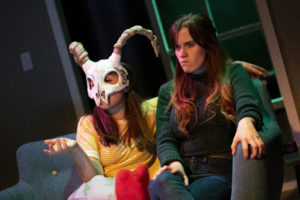 necessarily in sequence or in sync with each other. On occasion, the same scene is redone from the point of view of the other character. The second act has longer scenes, which helps with character development and allows the loose strands of the script to be tied together in the mind of the audience.
necessarily in sequence or in sync with each other. On occasion, the same scene is redone from the point of view of the other character. The second act has longer scenes, which helps with character development and allows the loose strands of the script to be tied together in the mind of the audience.
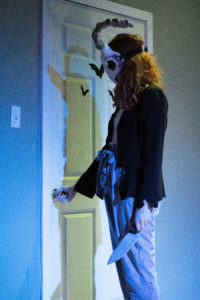 Today “gender casting” is well-established on stage, with men playing women and vice versa, and non-binary and trans individuals playing characters whose sexuality they may or may not identify with. The problem with Theatre L’Acadie’s production of “70 Scenes of Halloween” is that of “gender miscasting.” This makes an intentionally disjointed script needlessly confusing and difficult to follow.
Today “gender casting” is well-established on stage, with men playing women and vice versa, and non-binary and trans individuals playing characters whose sexuality they may or may not identify with. The problem with Theatre L’Acadie’s production of “70 Scenes of Halloween” is that of “gender miscasting.” This makes an intentionally disjointed script needlessly confusing and difficult to follow.
In the current production, Jess and Joan are a lesbian couple with Jess generally having more “male attributes” and Joan having more “female attributes”, however defined. Yet throughout the performance, there are flashbacks to the Jess and Joan of the past when the two were a happy couple. In these scenarios, played by Hoch and Blair, Jess and Joan are a straight couple (as Blair is male and Hoch is female). This makes the various recollections unclear for the audience. Similarly, when the psychologically and spiritually damaged couple are represented as having physical wounds, again the depiction is that of a straight couple. The problem is that Champagne and Blair look nothing like each other, not only in terms of their gender but in their physique, hairstyle, mannerisms, and so forth.
If the show is trying to make a point about Jess and Joan’s intimate relationship that has gone haywire, it would be clearer and more straightforward with strict gender norms to depict a traditional heterosexual marriage. Having a 1950’s-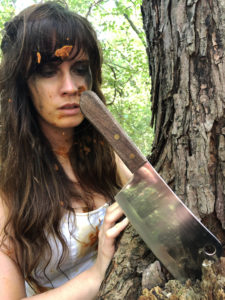 type man play Jess in all situations would pierce through the confusion and provide for more continuity and consistency throughout the performance.
type man play Jess in all situations would pierce through the confusion and provide for more continuity and consistency throughout the performance.
The name Jess is very close to Jeff, or Jeffrey M. Jones, the playwright, whose script is about his own marital infidelity in a straight relationship. The current production, with two women cast in a lesbian relationship, does not necessarily carry the same weight regarding role expectations. No matter how one draws or redraws the lines regarding sex and gender, the sexual tension and power relations are not the same when the gender roles are more fluid and less conventional.
To explain this succinctly, the differential status between the two spouses must be made more rigid and apparent to the audience in order to make the dynamics of the play work. This goes back to the playwright’s relationship with his wife and his perceptions of how men and women are each supposed to interact within the context of marriage. He illustrates this as a culturally defined polarity, based on externally reinforced hierarchical expectations for traditional sex roles. Therefore, the dissolution of his marriage is, in part, based on the dashing of expectations for a couple’s behavior.
Let me provide an example. At the beginning, Jess and Joan argue about who should answer the door on Halloween night. Since we are dealing with a gay/lesbian relationship, we are absent the more obvious sexual tension inherent to a relationship between traditional heterosexual spouses, where a man might expect a woman to answer a door simply because she is a woman, or a woman might expect a man to want her to answer the door—or the man might choose to deviate from his normal role expectation to help out his wife. When two women (or for that matter, two men) argue about a ringing doorbell, this lacks the traditional expectations regarding the “sexual hierarchy.” Therefore, if the door (and later the television) scenarios are supposed to signify the beginnings of marital discord, they must be indicative of some deeper fault within the relationship. Jumping from relatively minor incongruity to all the way to adultery makes little or no sense otherwise.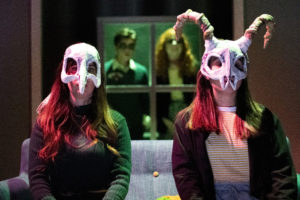
This troublesome issue with the sexual dynamics in this production is not to take anything away from Champagne’s stellar achievement. As Jess, she is convincing as a lover and companion and terrifies each and every one of us in the audience when she screams at the top of her lungs with guilt for her unconscionable fling. She hauntingly cries out in pain with regret for deeply hurting the woman she loves. With amazing vivaciousness, she demonstrates the full extent of how her life has precipitously gone to hell. The abdication of her personality allows the specters to march in, representing guilt, doubt, anguish, and fear.
Expect lots of terror in this play and the ghastly use of knives. The cutout of bats on the closet door and the blood-spattered painting in the background are a nice touch. The horror is chilling.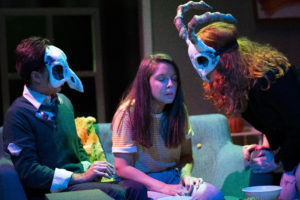
Speaking of chilling, a refrigerator truck was parked right by the entrance to the Athenaeum Theater, practically blocking the front door. I was told that it had to do with the nearby St. Alphonsus’s Church and its annual Oktoberfest, geared to start the next day and run through the weekend. The Thursday, September 26th performance of “70 Scenes” was therefore billed as an “invited dress rehearsal”, as the production had to take a break because of the celebration next door. So… don’t just binge on some candy corn: It’s time to chill out with a pierogi and a beer!
 “70 Scenes of Halloween”, directed by Emily Daigle and performed by the Theatre L’Acadie company, is playing in Studio Theater One, at the Athenaeum Theater, 2942 N. Southport Avenue, Chicago, from October 2-13, 2019.
“70 Scenes of Halloween”, directed by Emily Daigle and performed by the Theatre L’Acadie company, is playing in Studio Theater One, at the Athenaeum Theater, 2942 N. Southport Avenue, Chicago, from October 2-13, 2019.
Performances are at 8:00 p.m. Wednesday through Saturday, and 3:00 p.m. on Sundays.
Tickets are $20 general admission, $15 for industry tickets. Group rates are available for those who inquire.
For tickets, please call 773-935-6875 or go to www.athenaeumtheatre.org.
To see what others are saying, visit www.theatreinchicago.com, go to Review Round-Up and click at “70 Scenes of Halloween”.





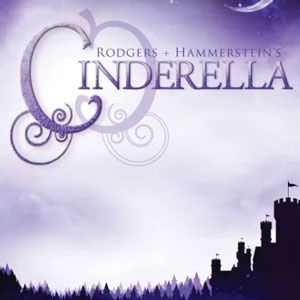
More Stories
” A Christmas Carol” reviewed by Paul Lisnek
“Pilot Island & Her Keepers” reviewed by Julia W. Rath
“Rodgers and Hammerstein’s Cinderella”